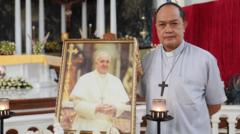As the sun rises over the Vatican on May 7, 2025, the atmosphere is charged with anticipation. The first papal conclave in twelve years is set to commence following the death of Pope Francis, who passed away on April 21. Cardinal electors, 133 in total, will gather in the Sistine Chapel after a morning Mass in St. Peter's Basilica to begin the crucial process of electing his successor.
Papal Conclave Begins: A New Era Awaits

Papal Conclave Begins: A New Era Awaits
The Vatican prepares for the first papal conclave in over a decade following Pope Francis's passing, setting the stage for significant changes.
The procession at 4:30 p.m. local time will see the cardinals solemnly walk from the nearby Pauline Chapel to the Sistine Chapel. When the master of pontifical liturgical celebrations announces “extra omnes,” it will mark the moment when all non-electors must vacate the premises, ensuring an atmosphere of secrecy and focus for the voting procedure. For the duration of the conclave, the cardinal electors are confined to Vatican City, only able to leave for meals and evening rest. All forms of communication with the outside world, including phones and internet access, are strictly prohibited to maintain the integrity of the voting process.
The conclave is scheduled to begin 16 days after the pope’s death, falling within the customary timeframe of 15 to 20 days. This timing also reflects the logistical aspects tied to the funeral arrangements and the preparations made by the Vatican for this significant event. Cardinal electors have already convened to discuss pressing issues facing the Catholic Church, setting a foundational dialogue before the official start of the conclave.
Preparations for the conclave have included closing the Sistine Chapel to tourists and establishing the infrastructure necessary for the voting process, including the necessary incineration stoves for the cardinal's ballots post-vote. As the world watches, this conclave marks a pivotal moment in the history of the Catholic Church, with the potential for seismic shifts depending on the direction the newly elected pope may choose to take.
The conclave is scheduled to begin 16 days after the pope’s death, falling within the customary timeframe of 15 to 20 days. This timing also reflects the logistical aspects tied to the funeral arrangements and the preparations made by the Vatican for this significant event. Cardinal electors have already convened to discuss pressing issues facing the Catholic Church, setting a foundational dialogue before the official start of the conclave.
Preparations for the conclave have included closing the Sistine Chapel to tourists and establishing the infrastructure necessary for the voting process, including the necessary incineration stoves for the cardinal's ballots post-vote. As the world watches, this conclave marks a pivotal moment in the history of the Catholic Church, with the potential for seismic shifts depending on the direction the newly elected pope may choose to take.





















